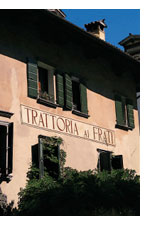| |
|
|
WINES AND
AGRICULTURAL
PRODUCTION |
|
| |
 n
1958, the Beretta family, owners of Palazzo Moroldi, had a vision.
They wanted to donate the frescoes painted by Chiarottini in the
internal gallery that now bears his name to the Civic Museums. n
1958, the Beretta family, owners of Palazzo Moroldi, had a vision.
They wanted to donate the frescoes painted by Chiarottini in the
internal gallery that now bears his name to the Civic Museums.
The family were prevented from doing so by the love of art of Carlo Someda De Marco. The director of Udine’s Civic Museums pointed out that there was a risk that once the frescoes had been removed from the walls of the palazzo, they might deteriorate irreparably. And so, even today, the frescoes on Chiarottini’s gallery embellish what has in the meanwhile become the main point of reference for the world of Friulian
viticulture.
Today, Palazzo Moroldi, which is situated right in the centre of Udine in Via
Poscolle, houses the Casa del Vino, or “Home of Wine”.
|
|
For anyone who wants to get to know the region’s agriculture and food products, a visit to the Casa del Vino is a must. Displayed on the shelves in the main reception room is a selection of Friuli’s most characteristic wines, which invites visitors to discover other food products, from San Daniele prosciutto, to Montasio cheese, grappas, honey and all the other delights. Together, they embody the tradition of “doing things well” that has always been typical of Friuli.
If we think about it, the same desire to “do things well” that prevented the destruction of Chiarottini’s frescoes is also responsible for the world-famous excellence that has now come to be synonymous with Friulian
products. Any tour of this little universe has to start from the Casa del Vino.
|
|
|
|
Palazzo Moroldi, built in the sixteenth century as a detached residence, is today squeezed in among the buildings that form Udine’s historic centre, a stone’s throw from Piazza Libertà, which has been called the loveliest Venetian piazza on the mainland.
As well as a fine selection of Friuli’s best wines, Palazzo Moroldi, also has everything required to stage full-scale professional tastings for wine specialists and journalists. The centre is managed by ersa, the regional body for the promotion of agriculture, and ersa staff are on hand to provide tourists and connoisseurs with information on Friuli’s premium-quality food and agricultural products.
Udine lies in the centre of a region where
maintaining the high quality of food and agricultural products
is a way of life for local farmers and manufacturers. The Casa del Vino was therefore the obvious place to put the best
of that production on display. And Udine is also the hub for the
various itineraries that will take the visitor in a very few
kilometres to the production zones of Montasio cheese (to the
west in the provinces of Udine and Pordenone), of air-cured ham,
or “prosciutto” (at San Daniele and - for small quantities of
superb-quality smoked ham - to Sauris), and, naturally, of Friuli’s
great wines. The region accounts for a tiny proportion (just 2%)
of Italy’s total wine production but in terms of quality, Friuli’s
output is very significant indeed.
The Casa del Vino was therefore the obvious place to put the best
of that production on display. And Udine is also the hub for the
various itineraries that will take the visitor in a very few
kilometres to the production zones of Montasio cheese (to the
west in the provinces of Udine and Pordenone), of air-cured ham,
or “prosciutto” (at San Daniele and - for small quantities of
superb-quality smoked ham - to Sauris), and, naturally, of Friuli’s
great wines. The region accounts for a tiny proportion (just 2%)
of Italy’s total wine production but in terms of quality, Friuli’s
output is very significant indeed.
|
|
Udine is the ideal starting point for tourists on the trail of the flavours most intimately linked to the historic and cultural
heritage of Friuli-Venezia Giulia. A few days spent in the city afford the opportunity to get to know its artistic heritage but they will also enable the visitor to discover the secrets of a food and wine culture that has been celebrated since the days of the Roman Empire.
It was from Aquileia that ships laden with amphorae of wine for the emperor’s table used to set sail. In later centuries, those same wines were prized at royal courts across Europe, thanks above all to the industry of Fabio Asquini. Thanks to Asquini’s tireless diplomatic and commercial efforts in the eighteenth century, Picolit later to establish itself as the prince of Friulian wines went from its home in the hills near Udine to achieve international fame well beyond the boundaries of Friuli.
Another excellent way to get to know traditional local products is to visit the Casa della Contadinanza on the castle hill. Designed as a focal point for the promotion of Udine’s food and agricultural produce, it was built next to the castle itself in the early twentieth century. Udine castle was the seat of one of Europe’s earliest democratic institutions, the parliament of Patria del Friuli, which sat during the period of the Patriarchate of Aquileia. In those days, the Contadinanza was the institution that safeguarded the interests of country-dwellers. The original Casa della Contadinanza, which stood at the foot of the castle hill, was used to store weapons which might be needed to mount a defence. It is still possible today to walk where the castle’s defenders once stood but only to find out more about Friuli’s art, culture and culinary heritage. |
|
|
